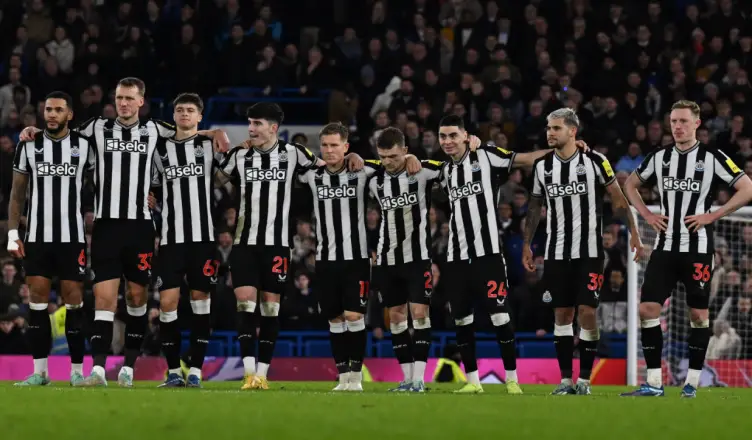Historically, a hospital and chapel named St. James’ stood near where the Hancock Museum building now stands in Newcastle. In 1542, the master of St. Mary’s and St. James granted a lease of land and plots that extended to Castle Leazes. St. James Place was later built on the site, and the area continued to develop. By the early 19th century, there were St. James Street, St. James Terrace, and Leazes Terrace.
Fast-forward to that first match on the site in 1880, and it’s easy to see why the ground immediately became known as St. James’ Park. At either end of the ground now are the Leazes End and Gallowgate End. One is named after the neighboring Leazes Park and Leazes Terrace, and the other after the city’s infamous gallows – last used in 1844. As you can see, Newcastle United history is quite deep, but we will now explore it by going over the key stages.
What is the Story of Newcastle United?
The First Kick
The connection between our home and ‘the beautiful game’ predates the club’s birth. The first organized practice match on the site took place in 1880. This happened 12 years before the official formation of Newcastle United. It involved Newcastle Rangers, who formed in 1878 and played initially on the Drill Field in Gateshead. After moving north of the River Tyne, Newcastle Rangers relocated to Byker in 1882. However, they returned in 1884 before eventually folding. As a replacement, West End Football Club took up the tenancy in 1886, two years later.
Entering the World of Top Teams
The new century brought good fortune to Newcastle, as they dominated the First Division, securing titles in 1905, 1907, and 1908. However, the lowest point in their history came with a heavy defeat to Sunderland in 1908 – a crushing 9-1 loss. Despite this setback, Newcastle claimed their first FA Cup trophy, only to have their promising run disrupted by World War I.
After the war, the club made a triumphant return with another FA Cup win in 1924. They added talented player Hughie Gallacher, who became their captain and led them to another League title in 1927. Another FA Cup victory followed in 1932, but a period of mediocrity ensued, resulting in relegation to the Second Division in 1934.
Newcastle didn’t stay down for long, making a strong comeback after World War II. Led by the legendary Jackie Milburn, they returned to the top flight in 1948 and went on to win three FA Cups between 1951 and 1955, establishing themselves as Cup specialists. Despite deep runs in English Cups in the following decades, additional silverware remained elusive.
You can watch some old games involving Newcastle United and evaluate their level of play. However, you may need a VPN for this. Don’t be afraid, easy VPN configuration Apple TV will help you. We have VeePN in mind, which can unblock web archives and modern streaming services. It even has a free trial period.
Politics
After United’s cup-winning exploits of the 1950s, the sixties became a frustrating period for both the club and the football-loving public of Tyneside. The city, unfortunately, missed out on hosting World Cup matches in 1966. During the years leading up to the competition, planning difficulties repeatedly halted the ground’s development. As a result, World Cup fixtures were allocated to Middlesbrough’s Ayresome Park instead.
Rising in the East
United contemplated relocating, but in 1971, they experienced a breakthrough. Following over 50 years without a significant stadium overhaul, then Minister for Sport, Denis Howell – a former FA referee – intervened and approved plans for new stands. The cost of the project was estimated at £1m over ten years, contingent upon finances.
Construction for phase one commenced in 1972, which involved the creation of a new ‘East Stand’ to replace the Popular Side terrace. The East Stand, completed in 1973, stood as a testament to the club’s determination, even amidst a severe financial setback caused by an economic recession.
Unfortunately, due to the club’s relegation at the end of the 1977/78 season, plans to reconstruct the Leazes End were scrapped, despite its demolition just five years earlier.
The Premier League era
In the early 90s, a new era dawned upon the Premier League. It was marked by the appointment of Kevin Keegan as manager, instantly bearing fruit with Newcastle’s triumphant return to the top-flight in 1993. It was a good match that deserves to be reviewed. To do this, you just need to add a free VPN no download for your browser. Their meteoric rise continued, bolstered by star signings like David Ginola and Alan Shearer. Almost toppling Manchester United in 1996 and 1997, Newcastle narrowly missed out on the title, settlement for runners-up on both occasions.
The FA Cup finals in 1998 and 1999 proved to be heartbreak, followed by relative obscurity as the century turned. The 1990s saw a massive overhaul of the beloved stadium with capacity skyrocketing through multiple rebuilds, culminating in the creation of Europe’s largest cantilever roof.
Conclusion
If you’re thinking, does Newcastle United have history, then you definitely haven’t read this article yet. Newcastle United has a deep history and the team did not immediately become one of the favorites. They survived the war, won cups, and still offer a decent level of football.







